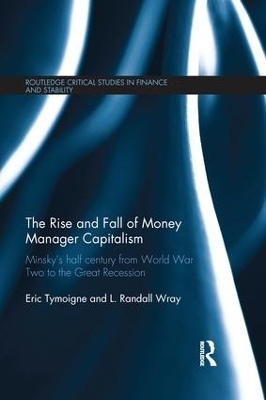
The Rise and Fall of Money Manager Capitalism
Minsky's half century from world war two to the great recession
Seiten
2016
Routledge (Verlag)
978-1-138-65016-9 (ISBN)
Routledge (Verlag)
978-1-138-65016-9 (ISBN)
- Titel z.Zt. nicht lieferbar
- Versandkostenfrei
- Auch auf Rechnung
- Artikel merken
The book studies the trends that led to the worst financial crisis since the Great Depression, as well as the unfolding of the crisis, showing that Minsky’s approach can be used to draw some policy implications to improve financial stability.
The book studies the trends that led to the worst financial crisis since the Great Depression, as well as the unfolding of the crisis, in order to provide policy recommendations to improve financial stability. The book starts with changes in monetary policy and income distribution from the 1970s. These changes profoundly modified the foundations of economic growth in the US by destroying the commitment banking model and by decreasing the earning power of households whose consumption has been at the core of the growth process.
The main themes of the book are the changes in the financial structure and income distribution, the collapse of the Ponzi process in 2007, and actual and prospective policy responses. The objective is to show that Minsky’s approach can be used to understand the making and unfolding of the crisis and to draw some policy implications to improve financial stability.
The book studies the trends that led to the worst financial crisis since the Great Depression, as well as the unfolding of the crisis, in order to provide policy recommendations to improve financial stability. The book starts with changes in monetary policy and income distribution from the 1970s. These changes profoundly modified the foundations of economic growth in the US by destroying the commitment banking model and by decreasing the earning power of households whose consumption has been at the core of the growth process.
The main themes of the book are the changes in the financial structure and income distribution, the collapse of the Ponzi process in 2007, and actual and prospective policy responses. The objective is to show that Minsky’s approach can be used to understand the making and unfolding of the crisis and to draw some policy implications to improve financial stability.
Eric Tymoigne is Assistant Professor of Economics at Lewis and Clark College. His book Central Banking, Asset Prices, and Financial Fragility was published by Routledge in 2009. L. Randall Wray is a Professor of Economics at the University of Missouri-Kansas City.
Introduction: The Growth of Financial Fragility and the Great Depression 1. The Minskian Framework 2. From Management Capitalism to Money Manager Capitalism 3. The Great Moderation and the Growth of Ponzi Finance 4. Policy Implications for Finance 5. Policy Implications for Employment Conclusion: The Minsky Half-Century
| Erscheinungsdatum | 10.02.2016 |
|---|---|
| Reihe/Serie | Routledge Critical Studies in Finance and Stability |
| Zusatzinfo | 8 Tables, black and white; 91 Line drawings, black and white; 91 Illustrations, black and white |
| Verlagsort | London |
| Sprache | englisch |
| Maße | 156 x 234 mm |
| Gewicht | 580 g |
| Themenwelt | Geschichte ► Teilgebiete der Geschichte ► Wirtschaftsgeschichte |
| Sozialwissenschaften ► Politik / Verwaltung ► Staat / Verwaltung | |
| Wirtschaft ► Betriebswirtschaft / Management ► Rechnungswesen / Bilanzen | |
| Wirtschaft ► Volkswirtschaftslehre ► Finanzwissenschaft | |
| Wirtschaft ► Volkswirtschaftslehre ► Makroökonomie | |
| Wirtschaft ► Volkswirtschaftslehre ► Mikroökonomie | |
| Wirtschaft ► Volkswirtschaftslehre ► Wirtschaftspolitik | |
| ISBN-10 | 1-138-65016-1 / 1138650161 |
| ISBN-13 | 978-1-138-65016-9 / 9781138650169 |
| Zustand | Neuware |
| Informationen gemäß Produktsicherheitsverordnung (GPSR) | |
| Haben Sie eine Frage zum Produkt? |
Mehr entdecken
aus dem Bereich
aus dem Bereich


